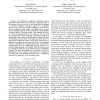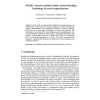305 search results - page 50 / 61 » Designing Pervasive Games for Learning |
HT
2000
ACM
13 years 12 months ago
2000
ACM
Software components for distance and just-in-time (JIT) learning are an increasingly common method of encouraging reuse and facilitating the development process[58], but no analog...
ICRA
2007
IEEE
14 years 1 months ago
2007
IEEE
Abstract— The problem of an effective coordination of multiple autonomous robots is one of the most important tasks of the modern robotics. In turn, it is well known that the lea...
ICALT
2005
IEEE
14 years 1 months ago
2005
IEEE
Apologizing or praising has various effects on people’s motivation levels. One way to employ emotions in computerized environments is to present humanized messages like apologet...
AIED
2011
Springer
12 years 11 months ago
2011
Springer
In this study, we designed and developed two educational games on mobile phones with support for speech-recognition to examine and train the cognitive underpinnings of word reading...
ATAL
2009
Springer
14 years 2 months ago
2009
Springer
Certain observable features (tags), shared by a group of similar agents, can be used to signal intentions and can be effectively used to infer unobservable properties. Such infere...


